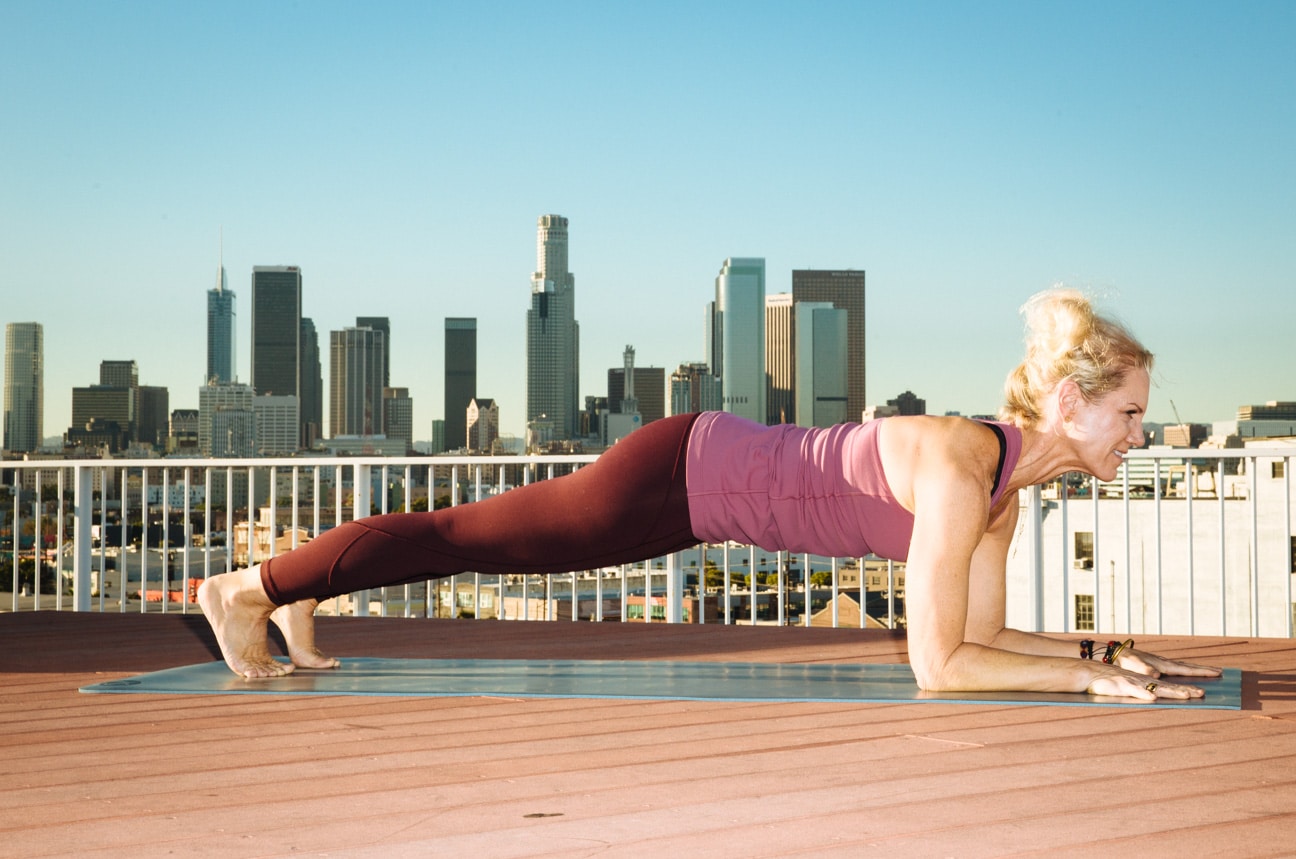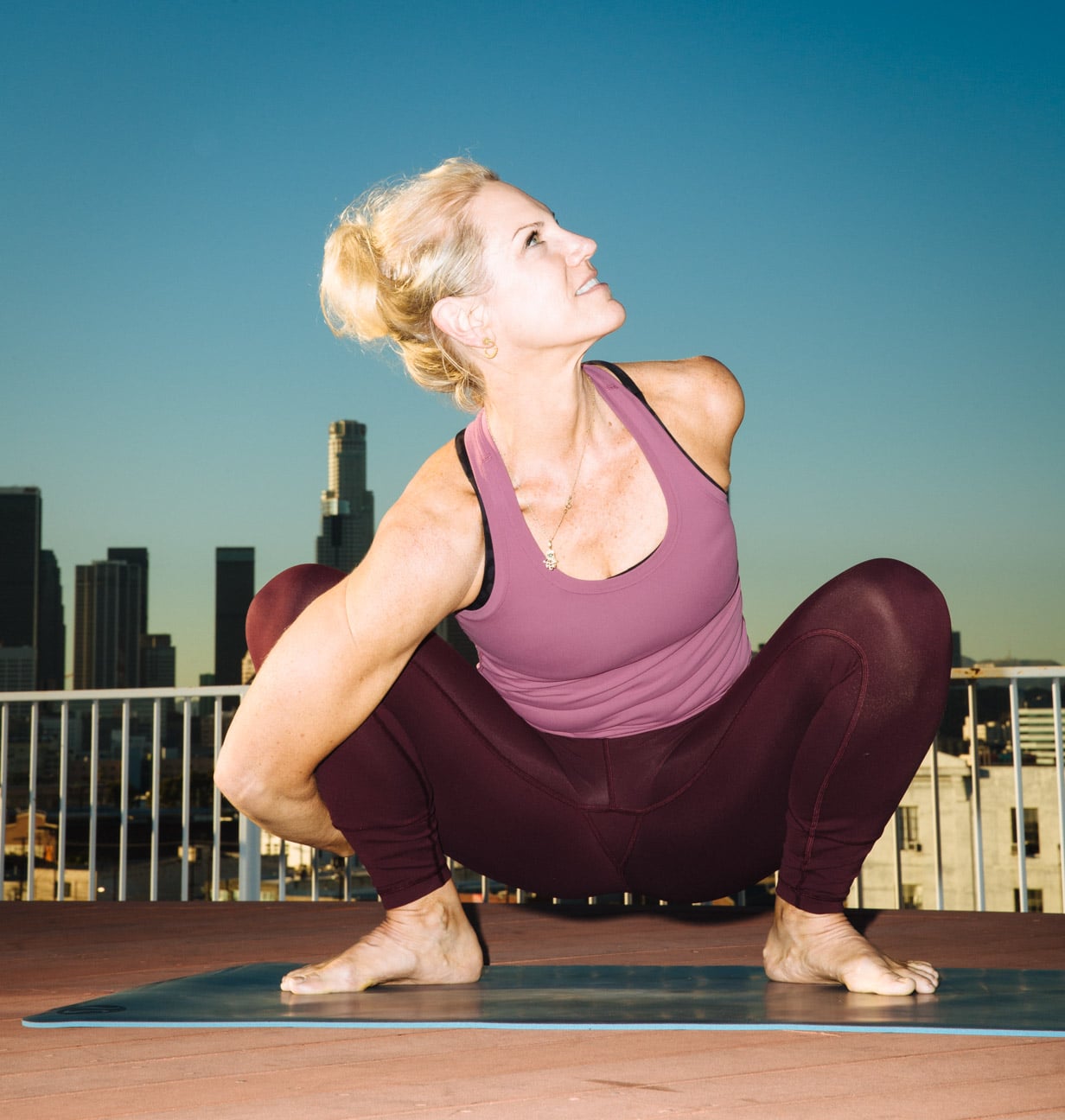by Andrea Marcum
Has this ever happened to you?
You’re halfway through the day, mid-meeting or conversation, and despite that double shot of espresso, B12 and CoQ10 you threw back, you’re still not really awake?
Awakening is the first step in a shift towards positive change.
In our body and mind we’re like those snow globes you shake and fill with chaotic, blinding snow until we stop, breathe, and let the “snow” of our agitated bodies and over-stimulated minds subside — allowing us to wake up to the landscape within and to fully inhabit our lives.
I have a morning routine that helps me settle my snow right out of the gate, so I can move into my day feeling present vs tense and conscious vs asleep.
Morning Routine for Awakening
Begin in child’s pose, or seated on blocks or pillows if that’s more comfortable. Feel the rise and fall of your breath. Think of nothing other than slowing your breathing down to a fuller, richer, wider inhale and more complete exhale. Stay for five full cycles of breath.
“Release for your tin-man spine”

Come onto all fours for cat/cow. (If your knees are unhappy here, pad them with a blanket or towel and/or feel free to keep your toes tucked under for more support.)
As you inhale, arch your back, pulling your chest through the gateway of your arms and lengthening your spine; as you exhale, round and dome your back, drawing your belly towards your spine. Try it on for size, and begin to find a rhythm — inhaling and exhaling, arching and contracting. Cat/cow is a delicious release for your tin-man spine and slumped-in-my-seat shoulders.
“A place to turn old ideas upside down”

Curl your toes under and find downward-facing dog. Even if you’ve done a bazillion of them, imagine this is your first downward-dog ever, and you’re feeling it in such a way as to describe every nuance to someone who won’t get the chance to do one of their own. Let it be a place to turn old ideas upside down and let same-old stories fall away.
“Feel yourself strong to the core”

Plank position is an opportunity to feel yourself strong to the core. (You can always lower your knees here for some support.) Work towards holding this plank for eight cycles of the rich deep breath you found in your first child’s pose. Then (perhaps with your knees down) lower onto your belly.
Sphinx Pose
Sphinx pose builds upon what we found in cat/cow. We traction our elbows toward our body, and sense an uplift of our heart that isn’t a whiplash to our neck. We can almost feel the gelatinous discs between our vertebrae thanking us for creating space and hydrating them. Stay for three breath cycles.
Core Beyond the Six-Pack

Forearm plank is a safe way to warm up just about every bit of us. We are 360 creatures so our core is not just that front-body six-pack we’re culturally obsessed with. Move your right forearm in and find side plank, waking up your oblique (side waist) muscles. A helpful trick might be to step the top foot like a kickstand in front of the bottom thigh. Hold for three – five breaths. Come through center and then slowly to your second side; back to center forearm plank once more, and then lower to sphinx.
“Long, strong backbend, not pretzel-posey”
In sphinx, move your hands back towards your waist alongside your ribs for a low cobra. This is a long, strong backbend, not one trying to be pretzel-posey. Draw your belly towards your spine and grow so elongated there’s nowhere to go but up — optionally, do the same with your legs until they lift. This posterior chain strength is essential to counter repetitive rounding movements in our day (chin-forward crumpled-texting position, I’m looking at you).
Follow Your Breath
Moving through hands and knees, find your way back to downward dog. From there, walk forward, feet to your hands at the front of your mat. Inhale, heart extends forward; exhale, fold in. Inhale, reach your arms overhead standing upright. Then exhale into mountain pose with your hands at your heart or along your sides.
Find Stillness
A mountain sits, no matter what swirls around it…changes in weather and seasons. We too have our weather (emotions) and seasons, and we can find the majesty of the mountain within us when we pause.
Sun Salutations

From mountain pose, inhale your arms up overhead. Exhale, swan dive forward. Inhale, gaze up, heart extending forward. Exhale, step one leg, then the other, back into your plank — take in an inhale here and, with your knees down (or, for some of you, knees off the ground) exhale and bend your elbows for chaturanga (streamlined low pushup).

At the end of your exhale in chaturanga, lower to your belly. Then, pull through to cobra as you inhale. Those of you more familiar with this flow might choose to glide from chaturanga into upward-facing dog. This means (at least in theory) that your belly stays off the floor as you roll over to the tops of your feet for your inhaling backbend. It doesn’t necessarily make anything more “advanced” or better to do up-dog instead of cobra, it’s just a different option. As you pay close attention, one alternative may feel intuitively better to you than the other. To me, that’s very sophisticated insight. Do anywhere from one to five of these with three breaths in down dog before you walk forward for your next round.
Twist

Finish your sun salutation(s) in downward dog, then walk your hands back to your feet and come into a full squat at the back edge of your mat. You might create a bench out of your block or blocks to sit on. With a bit of a twist in your torso, extend your right arm down towards the ground and your left arm up to the sky. Pause for a few breaths here and then head to side two.

Come down the middle in your full squat, and challenge yourself to come all the way up to standing (kindness prevails regarding knees and lower backs).
Wide-Legged Forward Fold

Now turn to the left long edge of your mat and step your right foot out four feet. Use the small edges of your mat to bring your feet parallel for this wide-legged forward fold. Perhaps interlacing your hands and taking your arms up and over, or feel free to use your blocks under your hands for more stability. Stay for five breaths, then firm through your feet and come all the way up to standing.
Mountain Into Tree Pose

Continue facing the long edge of your mat as you step your feet together into mountain pose. From your mountain grows a tree…
For tree pose, shift all your weight into your left foot and bring the bottom of your right foot into the inseam of your left thigh, calf or even ankle. Flexibility will have something to do with where this right foot ends up for you. It’s important not to feel that one expression of the pose is better than the other. We’re all unique combinations of genes, strength, balance and pliability. You yourself will be different depending on the day, what you’ve eaten, any injuries you’re working through, how much sleep you did or didn’t get… Over time and through the seasons, our trees will assume variegated shapes and forms. Get excited about wearing your own genes, not frustrated by trying to fit into someone else’s.
“Create deep roots as we widen our branches”
Bring your hands into a prayer in front of your heart or even extend your arms to the sky. Placing a hand on the wall is a great tool towards balance too. Tree is the perfect reminder to create deep roots as we widen our branches — both in this pose and in the day ahead. Stay as long as you can on the first side, then try the same configuration on side two.
When you’re done, step to the front edge of your mat in your mountain. Take a sun salutation as we did earlier, or simply step back into downward dog. Then walk through to seated and lie down on your back.
Bridge Pose

Bend your knees and place your feet hip-distance for a bridge pose. Either interlace your hands and snuggle your shoulders underneath you, or hold the sides of your mat as if trying to pull the mat apart. Enjoy one or several rounds here.
Supine Twist

Luxuriate in an easy supine (lying down) twist, pausing for five breaths on each side.
Reclining Pigeon
Cross your right ankle over your left knee and thread your right hand through the space to hold your left shin or hamstring in a reclining pigeon. You might prefer using the wall, leveraging your left foot on it as you cross the right ankle. A block under your head can help eliminate struggle through the neck and shoulders. Stay for a full minute, then switch sides.
Savasana
When you’re done with both sides, hug your knees into your chest and then let your body spill out across the floor for savasana.
B.K.S. Iyengar (the father of Iyengar-style yoga) likens savasana to a snake shedding its dead skin to reveal the vibrant colors of newness beneath. Savasana allows us to tune in, which, in turn, encourages us to make choices that come from mindful response instead of a stressed out, mindless reaction.
Cultivating Mindful Response
We make silly little choices all the time: what shirt to wear, what podcast to download, whether to follow someone on social media or not. Strung together, however, these choices are actually determining the path of our lives. If these seemingly insignificant moments are adding up to prodigious intervals, we want to ensure that they are leading us in the right direction. We need to pause, get clear, and remember the big picture our choices are designing.
Savasana is a potent place where we can awaken to our day without “snow” and take clarity with us out into our lives. You might think of it as the end of the practice, but I think it is actually the beginning. As poet T. S. Elliot said, “The end is where we start from.”
Stay in savasana for at least three minutes.
Then.
Awaken, fully, to your day.

Find Andrea’s book Close to Om here.
Looking for more? Head to closetoom.com for audio sequences and meditations.
Discover Andrea’s retreats around the world here
Andrea Marcum
Andrea is an author and yoga teacher who leads retreats and workshops around the world in both intimate and conference hall settings. She has a unique ease and familiarity about her, weaving accessible philosophy into the poses appropriate for a variety of experience levels. Andrea loves guiding the most unassuming newbies to yoga and mindfulness and works with everyone from athletes (Matt Kemp, LA Dodgers – NFL Network) to global brands (lululemon, Equinox, NBCUniversal, Well + Good) to celebrities and everything in between. Her critically-acclaimed book Close to Om is available from St Martin’s Press/Macmillan. Based in LA, Andrea teaches at Yogaworks and you can practice with her from anywhere on the Udaya and Gaia online platforms. andreamarcum.com Instagram @andreamarcum



